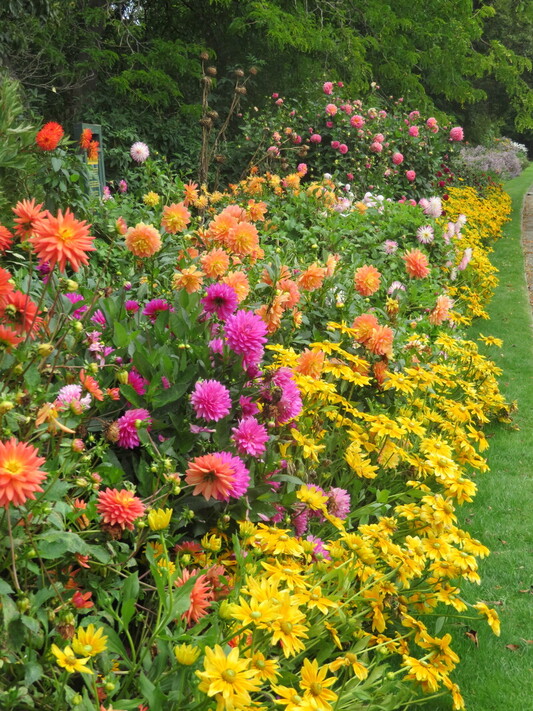|
When I visited the Timaru Botanic Gardens last year to take photos of the Robbie Burns statue I also took some of the colourful dahlia border that was still blooming profusely well into autumn. As we are settling in for the long lockdown ahead I thought it might be interesting to find out a little of the history about these beautiful and reliable garden performers. They are such a cheerful summer/autumn addition to a home garden, blousy, bold and available in an amazing variety of colours as well as being easy peasy as to grow. Dahlias originated in the mountain regions of Mexico and Guatemala and they still thrive there today. Before the time of the Aztecs not much is known about them but it is recorded that the Aztecs used parts of the dahlia for food and medicine.
In the 1570’s King Phillip ll of Spain sent a botanist, Francisco Hernandez, to Mexico to study the natural resources of the country and he described plants that resembled dahlias at that time. However it wasn’t until 1789 that plant parts were sent from the Botanical Garden at Mexico to the Royal gardens of Madrid in Spain. From there culture and propagation began and 3 new plant forms were grown. The genus was named after a Swedish botanist, Andreas Dahl. Seed and plant parts from the dahlias were sent throughout Europe from the early 1800’s and hybridization work continued. Double forms and colour variations resulted and captured the imagination and passion of plant breeders throughout Europe. Continued propagation and development of the earlier crosses resulted in the first modern dahlia hybrids being created around 1929. These new hybrids were easy to grown and hybridize so they quickly became very popular in European and American home gardens. Throughout the 1800s and 1900s thousands of new forms were developed and all of these new dahlia forms were hybridized from at least two, possibly all three of the original Dahlia species sent from Mexico in 1789. The dahlia we know today has one of the largest variations of form, colour and size of any flower grown and every year there are new varieties being developed and released constantly. It remains the National Flower of Mexico where its beauty, as well as usefulness, was first discovered by the Aztec Indians so long ago. We have our very own local dahlia specialists, Alistair and Joan Davey. Alistair was 13 years old when his great uncle gave him his first dahlia and that gift sparked a lifelong passion for these remarkable flowers. Have a look through his website, www.daveygardens.com and while away an hour or so plotting where you can perhaps squeeze one into your garden after this long winter ends. Keep well and safe, Karen Rolleston
0 Comments
Some recent photos on Wuhootimaru’s Face Book page featuring an old cottage on the outskirts of Pleasant point piqued my interest and I decided it needed following up.
James and Ellen Keane were immigrants from County Kerry in Ireland. They arrived in New Zealand on the 1st July 1861 after travelling aboard the “Chrysolite” which departed Gravesend, London in April of the same year. After landing in Lyttleton the Keanes spent 10 years living in Christchurch before they and their 5 children headed to their new home in South Canterbury. This hard working couple managed to get together enough money to buy a piece of farmland and build a home for themselves and their family to live in. The house they built is the substantial cob cottage that still stands on its original site to this day. This one is two storeyed with a large ground floor living room and an upper room or loft where the family all slept. The covered wagon or schooner they travelled south in stood on their property near the cottage well into the 1940’s. Cob cottages were well built and a favourite with our early settlers. Utilising the local soil and clay for the raw materials as well as labour and skills given by other community settlers it meant they were relatively cheap to construct. A feature is their excellent thermal protection that makes them suitable for extremes of climate. In terms of longevity, cob buildings have the potential to remain functional, with regular maintenance, for hundreds of years. This one has been well tended by past and present landowners, sited along Keanes Rd just off the Point highway; it is fenced apart from the surrounding farmland and well protected from stock. The cob has been restored, the tin roof is in good order and it has spouting which all help keep Keane’s Cottage in the great state it remains in today. Cob buildings were once a significant part of New Zealand's early history and census figures from 1845 recorded more than 40 per cent of building stock in the South Island was of earth construction. As times progressed and more building materials became available this percentage declined to the point where there are fewer than 200 earth dwellings in the South Island today. Karen Rolleston Last week’s column was about the Eleanor Howard Tripp Memorial Library that stands on a prominent corner of Woodbury’s main road. I received a copy of a newsletter that I thought was relevant in terms of the ongoing life of such treasured buildings within a community.
This Library was gifted to the community when it was completed in 1936 after Eleanor’s death. It is cared for, funded and staffed by local volunteers and there are many ongoing costs involved in terms of maintenance and insurances. Its existence relies on what can be raised from raffles and, perhaps, donations. As well as working to maintain the library these volunteers do an amazing job in also caring for the section, gardens and the War Memorial that stands in front of the library. Coming up this year, on Saturday the 4th of April, there will be a book fair and boot sale to be held at the Woodbury Hall to help with fundraising. It runs from 9am till 12 noon. This would be an enjoyable outing, as well as supporting a great cause it would be a chance for those interested to have a look around the Hall and Domain, St Thomas’s Church and the Memorial Library at the same time. The history room at the library is open on the first Sunday of each month between the hours of 11am to 2pm and would be an interesting place to while away a couple of hours. The building itself has a solar power unit installed to help reduce lighting costs. As I mentioned in last week’s column, during her lifetime Eleanor began a library for the staff who worked at her home at Orari Gorge Station. Owing to a misinterpretation on my behalf I need to correct a mistake I made in last weeks column, the books from Eleanor’s station library are all catalogued and listed as part of a private family library at her home station. Karen Rolleston Dotted about our rural communities are dozens of tiny libraries and there is a rather beautiful example of one of these charming buildings in the settlement of Woodbury.
This small wooden building was built by the residents of Woodbury in memory of Miss Eleanor Howard Tripp of Orari Gorge Station. It stands behind the war memorial positioned on a corner of the main road and is still in use today. There are two rooms on the site; one is a library room, the other a history room. Eleanor was a great reader and a believer in the value of education for all. She started a library for the staff in one of the out building at her home at Orari Gorge Station. This ran continuously for 100 years and the collection of books, which has been catalogued and listed with the Historic Places Trust, still exists in the Historic buildings that stand at the Station today. It is interesting to note that her sister, Katherine, known as Katie, started the Orari Gorge Station School around the same time. Eleanor was highly respected in the district and took a prominent but unobtrusive part in social welfare and charitable work. She was a long time committee member of St Saviour’s Orphanage and served in this role until the time of her death, after an illness of several months, at 69 years of age. She was also a Sunday School teacher and her pupils aided in the collection of the stones that went into the building of the St Thomas’s Church in Woodbury. This lovely church was built as a memorial to her parents, Charles George Tripp and Ellen Shephard Tripp of whom she was the third daughter. She was also a granddaughter of Bishop Harper. This beautiful memorial library sits quietly in its place, it tells a story of New Zealand’s past history and culture and is well worth a visit. Built out of respect and admiration for the work done by this gentle woman, it remains well cared for by local volunteers. Its hours of operation are listed on the notice board out front. Karen Rolleston |
View by date Archives
February 2021
Categories |
|
|






